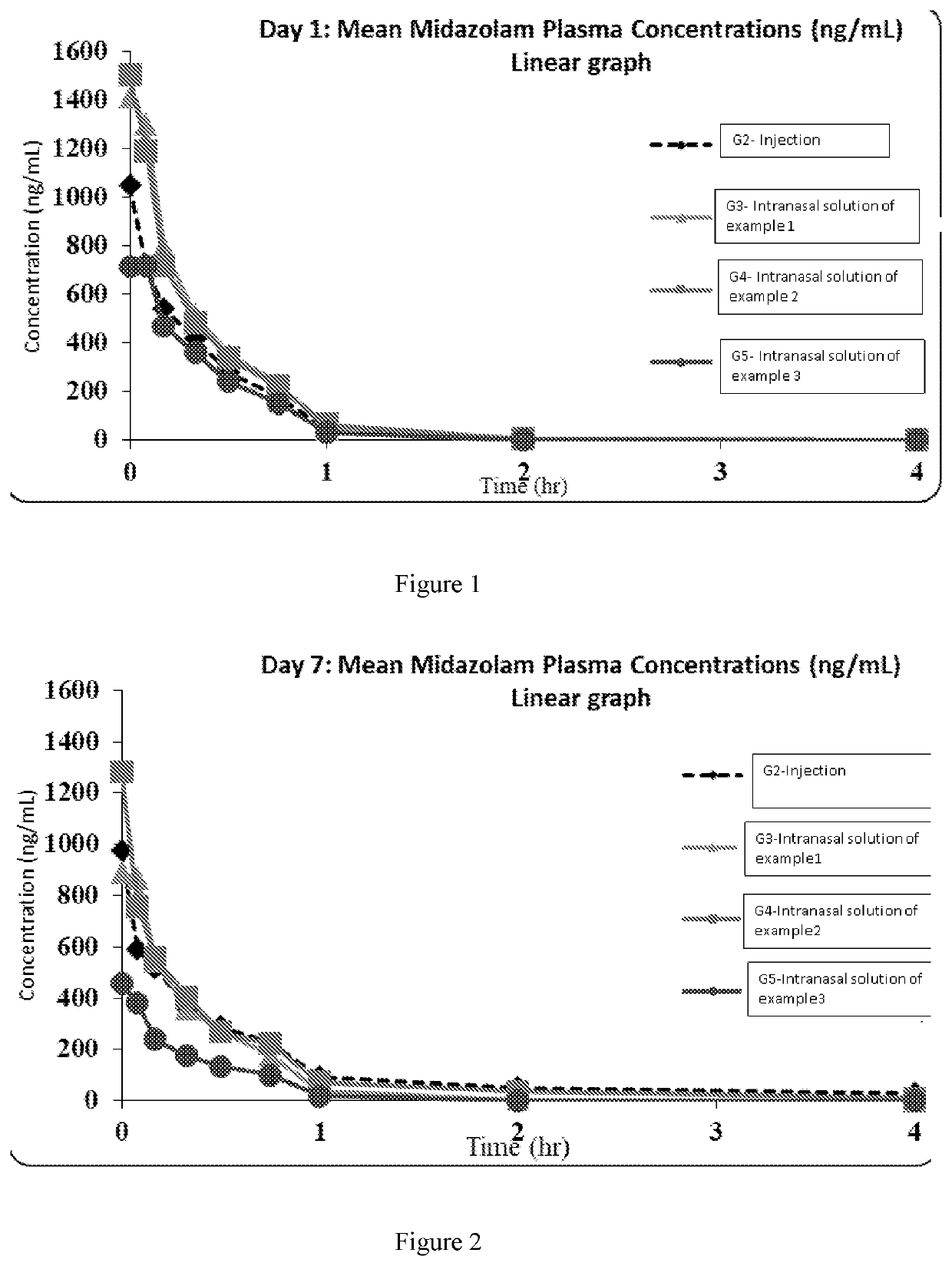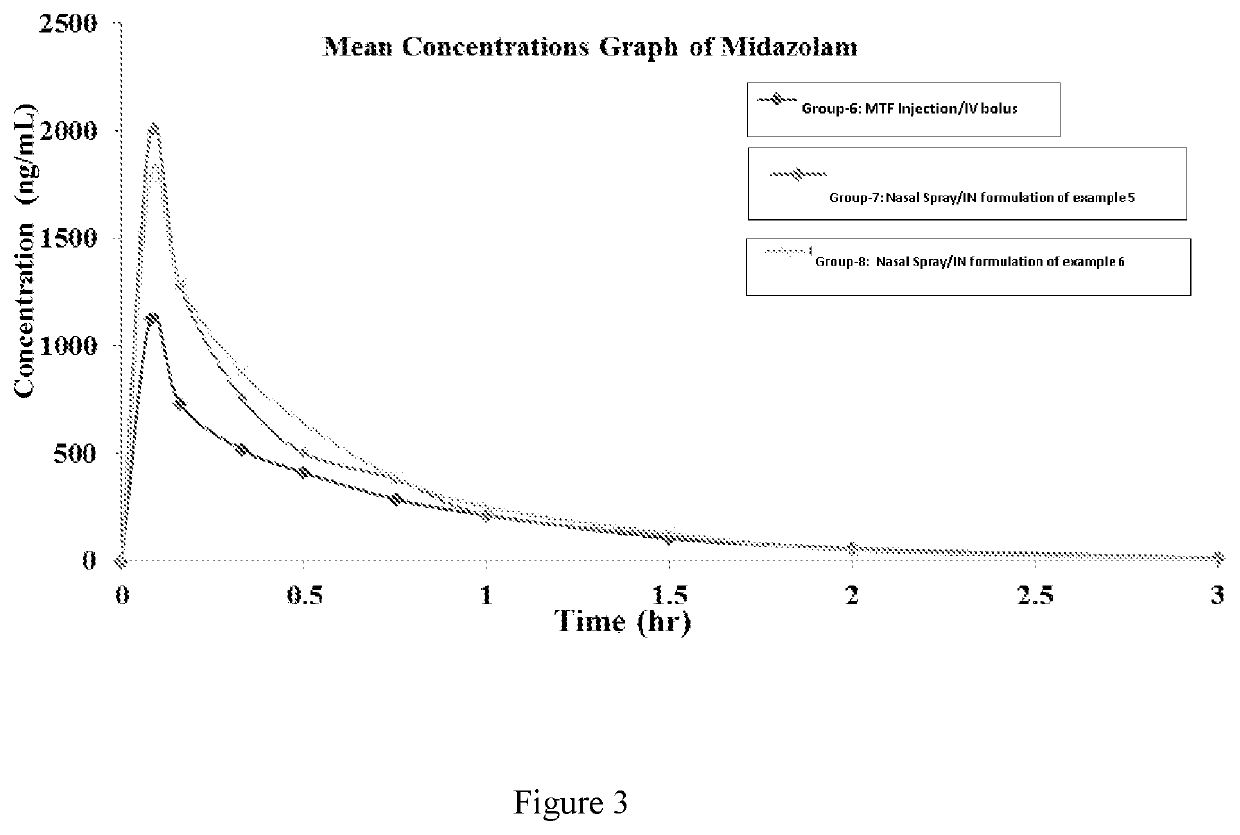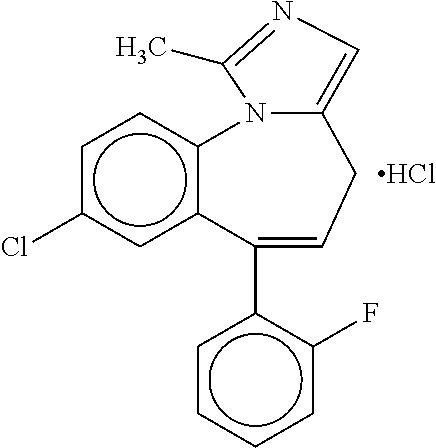Intranasal Formulation
a technology of intranasal and midazolam, which is applied in the direction of pharmaceutical non-active ingredients, pharmaceutical delivery mechanisms, organic active ingredients, etc., can solve the problems of only 10% of biological activity, minor active metabolite of midazolam, and disadvantages, etc., and achieve rapid peak plasma concentration, good bioavailability, and no toxic/irritation
- Summary
- Abstract
- Description
- Claims
- Application Information
AI Technical Summary
Benefits of technology
Problems solved by technology
Method used
Image
Examples
example 1
Nasal Solution
[0071]
TABLE 1Composition of nasal solutionQuantityIngredients(% w / w)Midazolam5Polysorbate 802.5Lactic acid10.52N Sodium hydroxide solutionq.s to pH 3.2Disodium edetate0.1Benzalkonium chloride0.02Purified waterq.sFinal pH target after3.2adjustment
Process of Preparation:
[0072]1. Water was heated till 90° on magnetic stirrer and then cooled by purging nitrogen.[0073]2. Polysorbate 80 was dissolved in some amount of water from step 1 and stirred for some time.[0074]3. Dispersed midazolam in the polysorbate 80 solution obtained in step 2 and white suspension was obtained.[0075]4. Dissolved separately disodium edetate in water and added to suspension of step 3 and stirred for some time.[0076]5. Added gradually some quantity of lactic acid to solution of step 4 under stirring until clear solution is obtained.[0077]6. Added benzalkonium chloride to the clear solution obtained in step 5 under stirring.[0078]7. Adjusted the pH of solution obtained in step 6 to 3.2 using 1N sodiu...
example 2
Nasal Solution
[0079]
TABLE 2Composition of nasal solutionQuantityIngredients(% w / w)Midazolam5Caprylocaproyl Polyoxyl-8 glycerides2Polysorbate 800.5Lactic acid10.5Disodium edetate0.1Benzalkonium chloride0.02Hydroxypropylmethyl cellulose 6 cps0.12N sodium hydroxide solutionq.s to pH 3.2Purified waterq.sFinal pH after adjustment3.2
Process of preparation[0080]1. Water was heated till 90° on magnetic stirrer and then cooled by purging nitrogen.[0081]2. Polysorbate 80 was dissolved in some amount of water from step 1 and stirred for some time.[0082]3. Dispersed midazolam in the polysorbate 80 solution obtained in step 2 and white suspension was obtained.[0083]4. Dissolved separately disodium edetate in water and added to suspension of step 3 and stirred for some time.[0084]5. Added gradually some quantity of lactic acid to solution of step 4 under stirring until clear solution is obtained.[0085]6. Added Caprylocaproyl Polyoxyl-8 glycerides, hydroxypropylmethyl cellulose and benzalkonium ch...
example 3
Nasal Microemulsion
[0087]
TABLE 3composition of microemulsionQuantityIngredients(% w / w)Midazolam5Polysorbate 8015Ethanol7Propylene glycol30Glyceryl Caprylate15Purified water28Disodium edetate0.1Initial pH6.4
[0088]Process of Preparation:[0089]1. Mixed polysorbate 80, propylene glycol and ethanol and stirred for 15 min to[0090]obtain yellow colored hazy dispersion.[0091]2. Added midazolam in the dispersion of step 1 to obtain clear and deep yellow[0092]dispersion obtained.[0093]3. Added Glyceryl Caprylate to dispersion of step 2 to obtain clear and deep yellow vehicle with very few drug particles remained suspended in[0094]the vehicle.[0095]4. Separately dissolved some quantity of Disodium edetate in water and added this[0096]solution to vehicle of step 3 to obtain clear and deep yellow colored dispersion.[0097]5. The volume was made up with water, filtered using 0.2 micron PES membrane[0098]filter and filled in 5 ml flint glass vial.
Example: 4 (Preclinical Studies)
[0099]The objective ...
PUM
| Property | Measurement | Unit |
|---|---|---|
| w/w | aaaaa | aaaaa |
| pH | aaaaa | aaaaa |
| volume | aaaaa | aaaaa |
Abstract
Description
Claims
Application Information
 Login to View More
Login to View More - R&D
- Intellectual Property
- Life Sciences
- Materials
- Tech Scout
- Unparalleled Data Quality
- Higher Quality Content
- 60% Fewer Hallucinations
Browse by: Latest US Patents, China's latest patents, Technical Efficacy Thesaurus, Application Domain, Technology Topic, Popular Technical Reports.
© 2025 PatSnap. All rights reserved.Legal|Privacy policy|Modern Slavery Act Transparency Statement|Sitemap|About US| Contact US: help@patsnap.com



